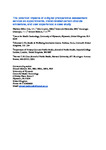The potential impacts of a digital preoperative assessment service on appointments, travel-related carbon dioxide emissions, and user experience: a case study
| dc.contributor.author | Milne-Ives, Madison | |
| dc.contributor.author | Leydon, J | |
| dc.contributor.author | Maramba, Inocencio Daniel | |
| dc.contributor.author | Chatterjee, Arunangsu | |
| dc.contributor.author | Meinert, Edward | |
| dc.date.accessioned | 2021-12-09T10:09:29Z | |
| dc.date.issued | 2022-02-16 | |
| dc.identifier.issn | 2561-9128 | |
| dc.identifier.issn | 2561-9128 | |
| dc.identifier.uri | http://hdl.handle.net/10026.1/18450 | |
| dc.description.abstract |
Background The National Health Service (NHS) cannot keep up with the demand for operations and procedures. Preoperative assessments can be conducted on the internet to improve efficiency and reduce wait times for operations. MyPreOp is a cloud-based platform where patients can complete preoperative questionnaires. These are reviewed by a nurse who determines whether they need a subsequent face-to-face appointment. Objective The primary objective of this study is to describe the potential impact of MyPreOp (Ultramed Ltd) on the number of face-to-face appointments. The secondary objectives are to examine the time spent on preoperative assessments completed using MyPreOp in NHS Trusts and user ratings of usability and acceptability. Methods The study design was a case study service evaluation. Data were collected using the MyPreOp system from 2 NHS Trusts (Guy’s and St Thomas’ and Royal United Hospitals Bath) and the private BMI Bath Clinic during the 4-month period from September to December 2020. Participants were adults of any age and health status at the participating hospitals who used MyPreOp to complete a preoperative assessment before a scheduled surgery. The primary outcome was the number of face-to-face appointments avoided by patients who used MyPreOp. The investigated secondary outcomes included the length of time spent by nurses completing preoperative assessments, associated travel-related carbon dioxide emissions compared with standard care, and quantitative user feedback. User feedback was assessed at all 3 sites; however, the other outcomes could only be examined in the Royal United Hospitals Bath sample because of data limitations. Results Data from 2500 participants were included. Half of the assessed patients did not need a further face-to-face appointment and required a median of only 5.3 minutes of nurses’ time to review. The reduction in appointments was associated with a small saving of carbon dioxide equivalent emissions (9.05 tons). Patient feedback was generally positive: 79.8% (317/397) of respondents rated MyPreOp as easy or very easy to use, and 85.2% (340/399) thought the overall experience was good or very good. Conclusions This evaluation demonstrates the potential benefits of MyPreOp. However, further research using rigorous scientific methodology and a larger sample of NHS Trusts and users is needed to provide strong evidence of MyPreOp’s efficacy, usability, and cost-effectiveness. | |
| dc.format.extent | e28612-e28612 | |
| dc.format.medium | Electronic | |
| dc.language | en | |
| dc.language.iso | en | |
| dc.publisher | JMIR Publications | |
| dc.relation.replaces | 10026.1/18448 | |
| dc.relation.replaces | http://hdl.handle.net/10026.1/18448 | |
| dc.relation.replaces | 10026.1/18448 | |
| dc.relation.replaces | http://hdl.handle.net/10026.1/18448 | |
| dc.subject | appointments | |
| dc.subject | cost-effective | |
| dc.subject | economic | |
| dc.subject | preoperative care | |
| dc.subject | preoperative period | |
| dc.subject | telehealth | |
| dc.subject | telemedicine | |
| dc.title | The potential impacts of a digital preoperative assessment service on appointments, travel-related carbon dioxide emissions, and user experience: a case study | |
| dc.type | journal-article | |
| dc.type | Journal Article | |
| plymouth.author-url | https://www.ncbi.nlm.nih.gov/pubmed/35171104 | |
| plymouth.issue | 1 | |
| plymouth.volume | 5 | |
| plymouth.publication-status | Published online | |
| plymouth.journal | JMIR Perioperative Medicine | |
| dc.identifier.doi | 10.2196/28612 | |
| pubs.merge-from | 10026.1/18448 | |
| pubs.merge-from | http://hdl.handle.net/10026.1/18448 | |
| pubs.merge-from | 10026.1/18448 | |
| pubs.merge-from | http://hdl.handle.net/10026.1/18448 | |
| plymouth.organisational-group | /Plymouth | |
| plymouth.organisational-group | /Plymouth/Faculty of Health | |
| plymouth.organisational-group | /Plymouth/Faculty of Health/Peninsula Medical School | |
| plymouth.organisational-group | /Plymouth/Faculty of Health/School of Nursing and Midwifery | |
| plymouth.organisational-group | /Plymouth/REF 2021 Researchers by UoA | |
| plymouth.organisational-group | /Plymouth/REF 2021 Researchers by UoA/UoA03 Allied Health Professions, Dentistry, Nursing and Pharmacy | |
| plymouth.organisational-group | /Plymouth/REF 2021 Researchers by UoA/UoA23 Education | |
| plymouth.organisational-group | /Plymouth/Research Groups | |
| plymouth.organisational-group | /Plymouth/Research Groups/Institute of Health and Community | |
| plymouth.organisational-group | /Plymouth/Users by role | |
| plymouth.organisational-group | /Plymouth/Users by role/Academics | |
| plymouth.organisational-group | /Plymouth/Users by role/Researchers in ResearchFish submission | |
| dc.publisher.place | Canada | |
| dcterms.dateAccepted | 2021-10-15 | |
| dc.rights.embargodate | 2022-1-8 | |
| dc.identifier.eissn | 2561-9128 | |
| dc.rights.embargoperiod | Not known | |
| rioxxterms.versionofrecord | 10.2196/28612 | |
| rioxxterms.licenseref.uri | http://www.rioxx.net/licenses/all-rights-reserved | |
| rioxxterms.licenseref.startdate | 2022-02-16 | |
| rioxxterms.type | Journal Article/Review |


